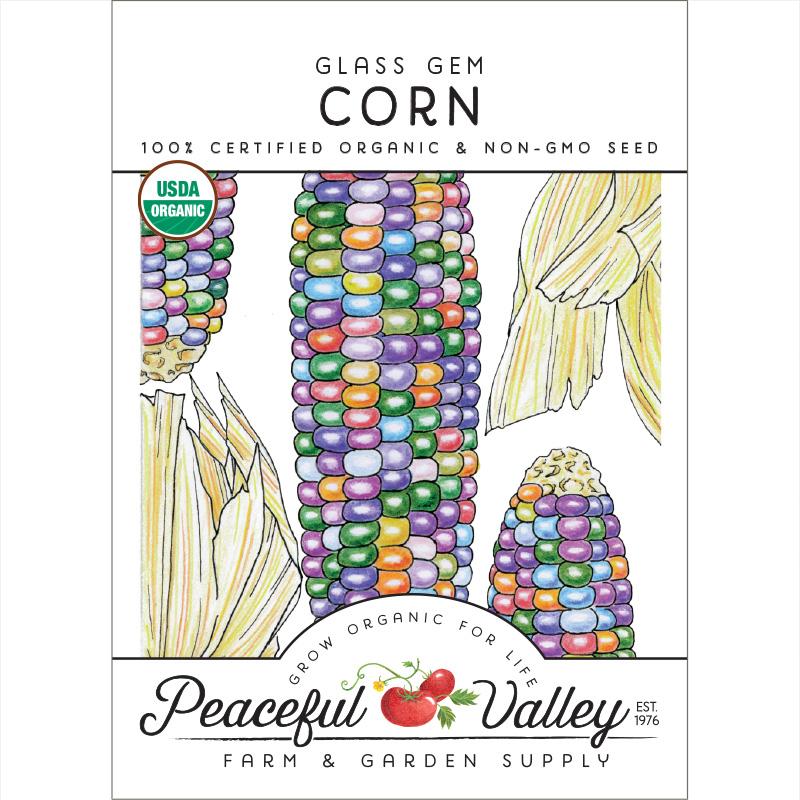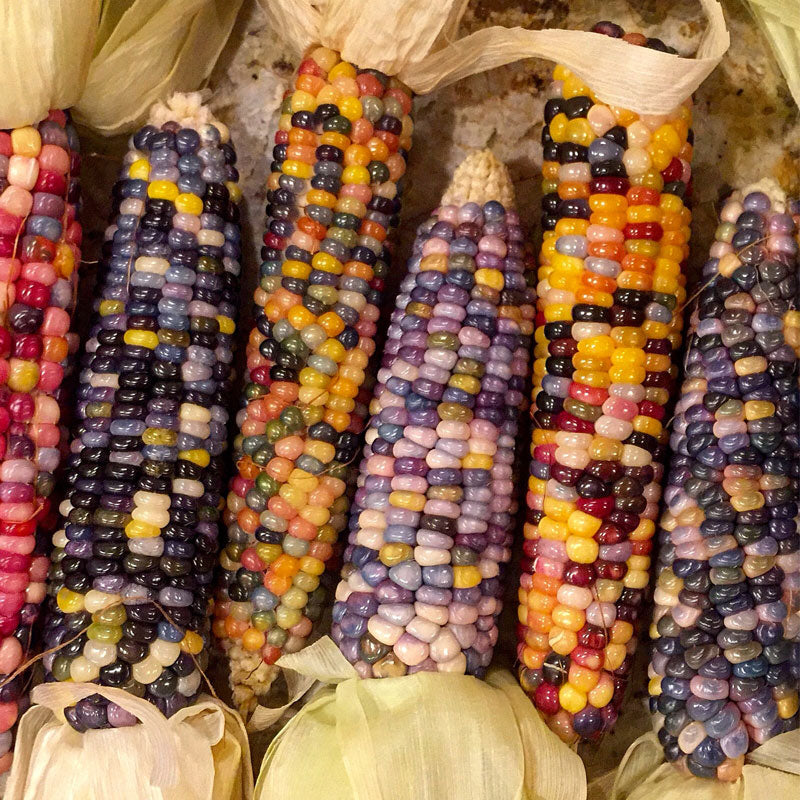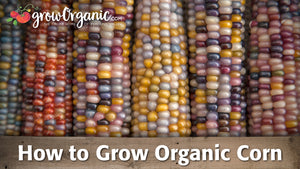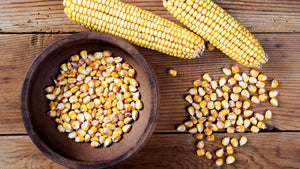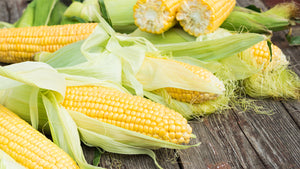Item Number: SNV8532
Glass Gem Corn Seeds (Organic)
Glass Gem Corn Seeds (Organic)
Glass Gem Corn: Very Colorful Ears with Many Uses
Corn - Glass Gem - Zea mays
Tender Annual Glass Gem grows 3-8" ears that are a rainbow of translucent colors. Corn can be used as decorative but is also good for eating. Can make cornbread, hominy, grits or popcorn from the colorful kernels.
Did You Know? This variety was bred by Carl "White Eagle" Barnes, the famous Cherokee corn collector. His life's work was collecting and preserving many native corn varieties.
Soil Temperature: 70-85°F
Planting Depth: 1"
Germination: 4-12 Days
Height At Maturity: 6-9'
Days to Maturity: 110-120 Days
Sun/Shade: Full Sun
Spacing After Thinning: 8"
Approx Seeds per Pack: 50 Seeds
Growing Glass Gem Corn: A Tapestry of Colors
Glass Gem Corn, a captivating variety of flint corn, has gained widespread popularity for its vibrant and multicolored kernels. This unique cultivar, deeply rooted in Native American heritage, tells a story of seed saving, agricultural artistry, and the dedication of individuals like Carl Barnes, an Oklahoma farmer with Cherokee descent. In this guide, we'll explore the fascinating journey of growing Glass Gem Corn, from its origins to cultivation practices.
Origins and Cultural Heritage:
Developed by Carl Barnes, a Cherokee farmer, Glass Gem Corn is a product of meticulous seed saving and cultivation.
Barnes, passionate about preserving Native American corn varieties, collected and isolated traditional types found in remote regions.
The Pawnee miniature, a small and multicolored corn, played a crucial role in the development of Glass Gem.
Meeting of Seed Savers:
In 1994, Carl Barnes met Greg Schoen, another seed saver, who was captivated by the beauty and diversity of Barnes' corn collection.
In 2005, Barnes entrusted Schoen with the seeds of Glass Gem Corn, marking a pivotal moment in its journey.
Bill McDorman, the executive director of Native Seeds/SEARCH, continued the cultivation and distribution of Glass Gem seeds.
Cultivation and Growing Conditions:
Glass Gem Corn is primarily grown for ornamental purposes due to its stunning array of colors.
It belongs to the flint corn category, known for hard and starchy kernels, making it suitable for grinding into cornmeal.
While its ornamental value is the main focus, Glass Gem Corn thrives in warm environments with a prolonged growing season.
Planting Glass Gem Corn:
The cultivation process begins with selecting well-drained, sandy loam soil rich in organic content.
Plant seeds in raised rows or mounds to manage the sprawling vines that can extend up to 20 feet.
Glass Gem Corn requires 70-90 days of warmth for optimal development, making it essential to choose a suitable location.
Watering and Maintenance:
Regular watering is crucial during fruit setting and growth phases, but caution is advised against overwatering.
The balance in watering, along with the right soil and temperature conditions, is crucial for successful Glass Gem Corn cultivation.
Harvesting and Utilization:
Glass Gem Corn is harvested when the kernels have fully matured and dried on the cob.
While primarily grown for its visual appeal, Glass Gem Corn can be ground into cornmeal for culinary use.
Preserving Agricultural Diversity:
The cultivation of Glass Gem Corn symbolizes the importance of seed saving and preserving agricultural diversity.
Its popularity among gardeners and farmers highlights the significance of maintaining Native American corn varieties.
Growing Glass Gem Corn is not just a horticultural endeavor; it is a celebration of cultural heritage and the dedication of individuals like Carl Barnes. From its origins in Native American traditions to its journey into the hands of modern cultivators, Glass Gem Corn continues to be a symbol of agricultural artistry and genetic diversity. Whether adorning gardens with its vibrant colors or gracing tables as cornmeal, Glass Gem Corn is a testament to the rich tapestry of history woven into the fields of cultivation.
For more information on growing corn, see our Growing Guide in the Resource Center.
Photo provided by Koby Guye

Check Your Zone Compatibility:
Compatible with your zone.
Growing Zone for
,

Our Guarantee To You
Since 1976, we've served our customers at every stage of growing. Please contact us at any time. We are happy to support and assist you.
Description
Description
Corn - Glass Gem - Zea mays
Tender Annual Glass Gem grows 3-8" ears that are a rainbow of translucent colors. Corn can be used as decorative but is also good for eating. Can make cornbread, hominy, grits or popcorn from the colorful kernels.
Did You Know? This variety was bred by Carl "White Eagle" Barnes, the famous Cherokee corn collector. His life's work was collecting and preserving many native corn varieties.
Soil Temperature: 70-85°F
Planting Depth: 1"
Germination: 4-12 Days
Height At Maturity: 6-9'
Days to Maturity: 110-120 Days
Sun/Shade: Full Sun
Spacing After Thinning: 8"
Approx Seeds per Pack: 50 Seeds
Growing Glass Gem Corn: A Tapestry of Colors
Glass Gem Corn, a captivating variety of flint corn, has gained widespread popularity for its vibrant and multicolored kernels. This unique cultivar, deeply rooted in Native American heritage, tells a story of seed saving, agricultural artistry, and the dedication of individuals like Carl Barnes, an Oklahoma farmer with Cherokee descent. In this guide, we'll explore the fascinating journey of growing Glass Gem Corn, from its origins to cultivation practices.
Origins and Cultural Heritage:
Developed by Carl Barnes, a Cherokee farmer, Glass Gem Corn is a product of meticulous seed saving and cultivation.
Barnes, passionate about preserving Native American corn varieties, collected and isolated traditional types found in remote regions.
The Pawnee miniature, a small and multicolored corn, played a crucial role in the development of Glass Gem.
Meeting of Seed Savers:
In 1994, Carl Barnes met Greg Schoen, another seed saver, who was captivated by the beauty and diversity of Barnes' corn collection.
In 2005, Barnes entrusted Schoen with the seeds of Glass Gem Corn, marking a pivotal moment in its journey.
Bill McDorman, the executive director of Native Seeds/SEARCH, continued the cultivation and distribution of Glass Gem seeds.
Cultivation and Growing Conditions:
Glass Gem Corn is primarily grown for ornamental purposes due to its stunning array of colors.
It belongs to the flint corn category, known for hard and starchy kernels, making it suitable for grinding into cornmeal.
While its ornamental value is the main focus, Glass Gem Corn thrives in warm environments with a prolonged growing season.
Planting Glass Gem Corn:
The cultivation process begins with selecting well-drained, sandy loam soil rich in organic content.
Plant seeds in raised rows or mounds to manage the sprawling vines that can extend up to 20 feet.
Glass Gem Corn requires 70-90 days of warmth for optimal development, making it essential to choose a suitable location.
Watering and Maintenance:
Regular watering is crucial during fruit setting and growth phases, but caution is advised against overwatering.
The balance in watering, along with the right soil and temperature conditions, is crucial for successful Glass Gem Corn cultivation.
Harvesting and Utilization:
Glass Gem Corn is harvested when the kernels have fully matured and dried on the cob.
While primarily grown for its visual appeal, Glass Gem Corn can be ground into cornmeal for culinary use.
Preserving Agricultural Diversity:
The cultivation of Glass Gem Corn symbolizes the importance of seed saving and preserving agricultural diversity.
Its popularity among gardeners and farmers highlights the significance of maintaining Native American corn varieties.
Growing Glass Gem Corn is not just a horticultural endeavor; it is a celebration of cultural heritage and the dedication of individuals like Carl Barnes. From its origins in Native American traditions to its journey into the hands of modern cultivators, Glass Gem Corn continues to be a symbol of agricultural artistry and genetic diversity. Whether adorning gardens with its vibrant colors or gracing tables as cornmeal, Glass Gem Corn is a testament to the rich tapestry of history woven into the fields of cultivation.
For more information on growing corn, see our Growing Guide in the Resource Center.
Photo provided by Koby Guye
Peaceful Valley Farm & Garden Supply brand seeds  are guaranteed to germinate. Once the seeds have sprouted, please understand that Peaceful Valley cannot be held responsible for the many uncontrollable growing and climatic conditions that must be met to ensure the success of your crop(s). Peaceful Valley brand vegetable seeds are all non-GMO and Certified Organic.
are guaranteed to germinate. Once the seeds have sprouted, please understand that Peaceful Valley cannot be held responsible for the many uncontrollable growing and climatic conditions that must be met to ensure the success of your crop(s). Peaceful Valley brand vegetable seeds are all non-GMO and Certified Organic.
Buy with confidence and plant the best!
Shipping Information
Shipping Information
Shipping Weight: 0.03 lb
Dimensions: 4.5"L x 3.25"W x 0.1"H
Features
Features
- Good Keeper
- Open-Pollinated
Characteristics
Characteristics
Planting & Care
Planting & Care
Soil and Water: Corn is a heavy feeder requiring high amounts of nitrogen, phosphorus, and potassium (NPK). Its weak and shallow root system likes loose soil with a high compost content.
Planting and Growing: Sow seeds directly outdoors 1 week after the last frost. You can start earlier by using black or green plastic mulches and floating row covers to obtain optimum conditions. Plant in blocks rather than rows to ensure good germination. To prevent cross-pollination, plant different varieties at least 500'.
Harvesting and Storage: Harvest when the husks are dry and brown. You will see the most translucent colors at this stage. Can be ground into meal or used for ornamental.
Useful Information
Useful Information
Guarantee
Guarantee

Peaceful Valley Farm & Garden Supply brand vegetable seeds are guaranteed to germinate. Once the seeds have sprouted, please understand that Peaceful Valley cannot be held responsible for the many uncontrollable growing and climatic conditions that must be met to ensure the success of your crop(s).
Share
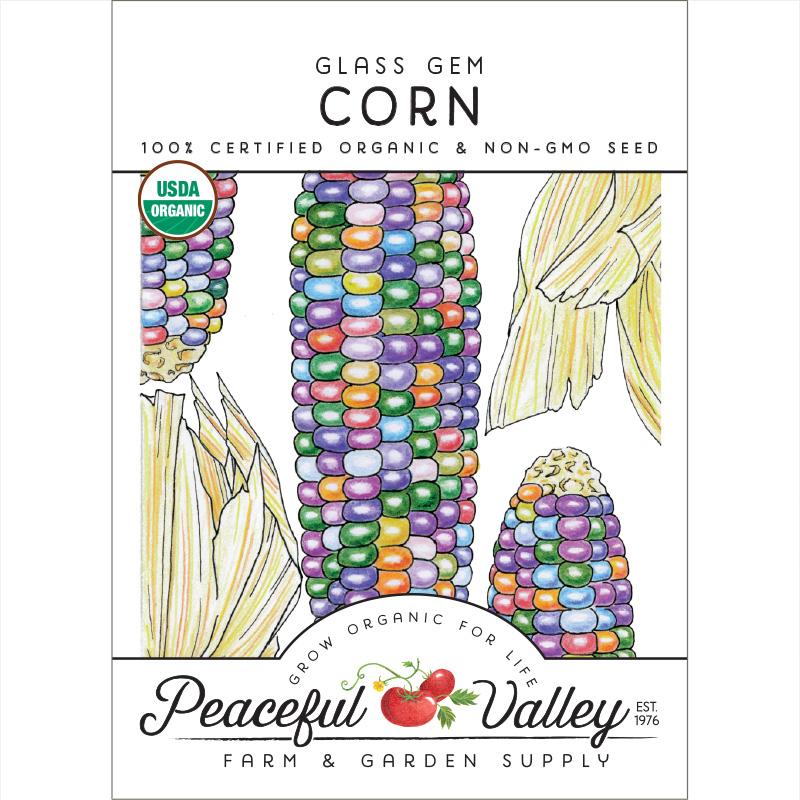
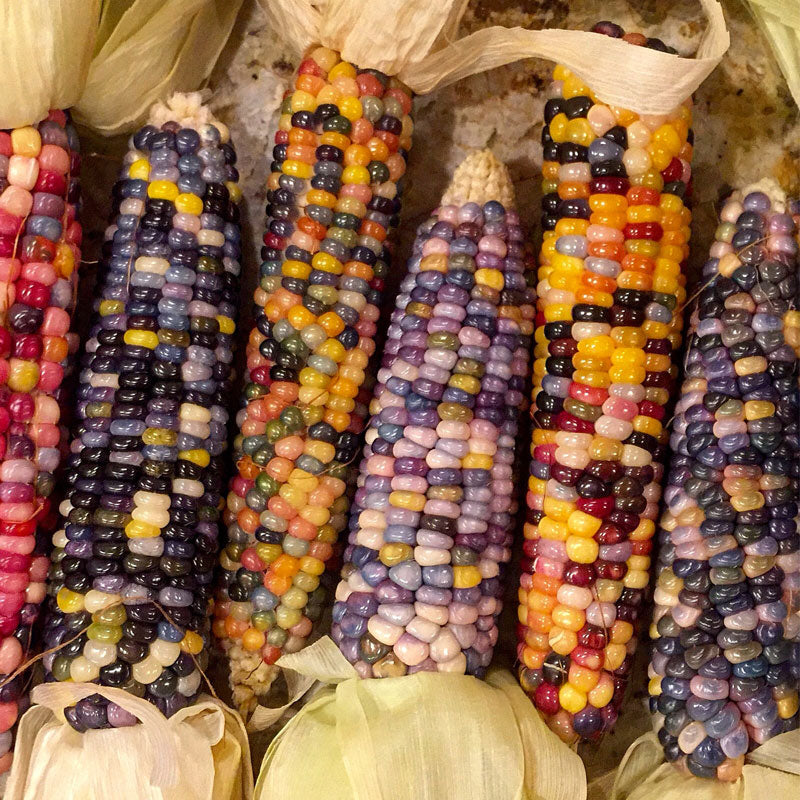
I found these at a seed exchange and took 6 seaglass green seeds and planted them hoping for a few small plants for my holiday decorations. They each grew into an 8 foot tall shrub and I have ~25 cobs of the most amazing colored corn! I wish I could post pictures.
Farmer Fred says I can plant corn weekly until July 4th so we’re giving it a go!! These are so beautiful my kid is going to flip!
Quick and consistent germination is great! Looking forward to seeing the beautiful ears of corn this fall.
I planted a packet of this in my garden and was very impressed with the excellent germination. Looks like all of the seeds I planted came up. Now if I can keep the birds away. I am excited about seeing the pretty ears of corn.
I was really excited for planting the beautiful seeds and hopeful for a nice crop to show off, but the seeds had poor germination. I planted a row next to my other corn and only 4 of the seeds sprouted. Felt defeated, but willing to give it another try after seeing the other review with a good germination rate.

